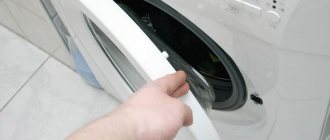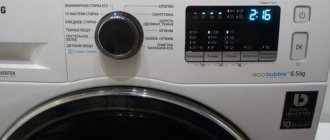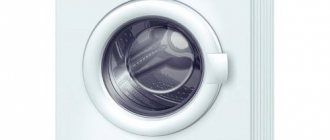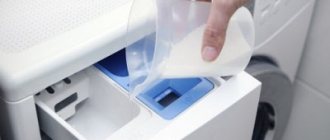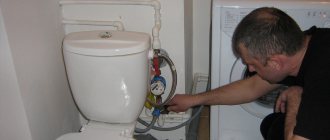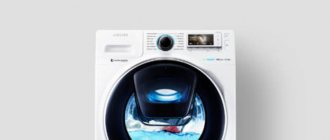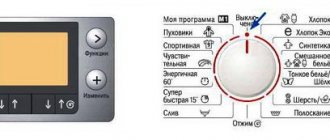Indication during the “Drain pump” test
Indication during the “Heater/heating element” test
Pol.6-9 Water inlet valve
Indication during the “Water inlet valve” test
Item 10 Sound signal test Sound signal
Section 11 Automatic test. Starts with a spin. (only for FCW) Section 12 Basic automatic test. For service
**Used on hot water only
a) Wait until level N1 is reached
b) Wait until the engine stops
c) Wait until level N0 is reached
d) Wait until the set speed is reached
Service test for Bosch Logixx washing machines
You can diagnose a malfunction in a Bosch washing machine using a service test.
Of course, you can start by searching for the circuits of the faulty device. But this will take time - you will have to disassemble, analyze, call, and so on.
The display shows all the necessary information to determine the breakdown. Errors are not saved in test mode. and are overwritten in the memory of the Bosch Maxx Logic8 washing machine.
To run the test you need:
— Close the hatch door — Set the program selection knob to “0” (“OFF”), wait two seconds
— Turn the selector knob clockwise to the “spin” position (6:00 o’clock position), the Start/Pause indicator will start flashing — Press and hold the “ button — Program selection knob to the “drain” position — release “
P1: Errors last program F: xx (error code)
Select a test program using the " " buttons
P1: Fault codes in memory P2: Safety test P3: Automatic test P4: Drive motor P5: Card coding P6: Screen P7: Button and program selector test P8: Water level sensor P9: Water turbidity sensor P10: Flow sensor P11: 3D sensor P12: Load detection test P14: Water fill valve P15: Sound test P16: Drain pump P17: Heating element
To start the test, press “Start/Pause”
This is what the initiation of error codes looks like on the display
Fault codes for Bosch Maxx Logixx 8 washing machines:
F16 the drum hatch is open, UBL malfunction F17 water intake time exceeded more than 10 minutes, malfunction of water supply, valves, aquastop, pressure switch F18 drain time more than 10 minutes, drain system malfunction. pump F19 malfunction of water heating, checking the pump, input voltage, relay and heating element, control board F20 unintentional heating of water. Inspection of the heating element, NTC sensor F23 aquastop has worked, water leakage, aquastop malfunction F25 aquasensor error, checking the sensor, pressure switch F26, F27 “jamming” » pressure sensor F28, F29 malfunction of the water flow sensor, electric valve, pressure switch, water pressure F31 water level is exceeded, inspection of the level sensor, valves, pump F34 malfunction of the UBL F36 error of the hatch lock, check of the UBL circuit and control module F37, F38 NTC sensor, heating element F42 high engine speed, inspection of the module and engine F43 no engine rotation, check of the motor, tachogenerator F44 no reverse, engine malfunction, module F59 3-D sensor error. inspection of the power module. 3-D sensor F60 flow sensor error F61 false UBL signal
Decoding
If the model is equipped with a display, F21 is displayed. Everything is clear here. On machines without a screen, the malfunction is indicated by blinking three spin indicators: 1000, 800 and drain.
- Tachogenerator malfunction.
- The brushes are worn out.
- The triac burned out.
- The relay that switches engine speed is damaged.
To check the first two points, you need to remove the motor. This is an important procedure that requires physical strength, as you will need to tilt the washing machine.
Main machine malfunctions
No water heating
If the machine stops heating the water completely, the automation will report this with a corresponding error. But it is possible that the heating is insufficient or slow. This can be understood by the increased running time of programs (especially if washed at high temperatures). The reasons may be as follows:
- Damage to the temperature sensor (thermostat)
The sensor looks like a silver cylinder. It is inserted from the outside into the hole of the heating element. There is wiring from the sensor to the control board. If the wiring is intact, the sensor cannot be repaired and must be replaced.
A heating element is a metal coil with an electrical conductor and a fuse inside. It is inserted into the working cavity of the washing machine under the drum, where it heats the water. From the outside, voltage and grounding from the control unit are connected to its terminals.
Failure is associated either with a burnout of the electrical circuit (fuse tripping), or with scale on the coil due to lime deposits. If the circuit of the coil itself is intact, then you can clean the working part of the heater with citric acid or special descaling agents. Otherwise, it is necessary to replace the heating element, which is not very difficult.
Typical malfunctions of Bosch washing machines
The most common problems are:
- no water heating;
- water is not drained;
- the drum does not rotate;
- noise and vibration;
- water does not fill in after starting the program;
- The electric motor does not work.
Let's consider each malfunction, indicating the possible causes that could lead to them.
Water doesn't heat up
The most vulnerable part of the equipment is the heating element (heating element); it is susceptible to breakdowns during intensive use of the device and poor water quality, as a result of which a thick layer of scale from salt deposits forms on it. The solution to the problem in most cases is to independently clean the heating element from scale or replace it. When using a washing machine with hard water, replacement is usually required after 3-5 years of operation.
There may also be no water heating due to the selection of an inappropriate washing program; in this case, re-read the instructions and select the appropriate program and mode.
Water does not fill
- low water pressure in the pipeline or shutdown of water supply;
- the filling valve is closed;
- breakdown of the water level controller or inlet valve.
Water does not drain
If water does not drain through the drain hose, you need to check the program selection. Some models have non-draining programs. If necessary, select the water drain mode.
All the reasons why the washing machine stopped draining water are described in this article.
A clogged drain hose that needs to be cleaned and rinsed can prevent water from draining. You also need to check the filter and pipe for the presence of small objects, hair and threads, wool. Other prerequisites may be pump malfunctions or malfunctions of the electronic board.
Washing machine repairs are best left to professionals.
We present to you our unique catalog of private masters and service centers - BigWash.ru
Select your city and artist in the filter: by rating, reviews, price!
The drum does not spin
Most modern models have built-in overload protection, that is, the drum will not rotate and washing will not start until excess items are removed from the drum. If after this, after twisting it with your hand, it rotates, you can start washing.
Other causes of malfunction:
- rupture or displacement of the drive belt;
- the heating element is burnt out;
- breakdown of the tachogenerator or pump;
- The electric motor does not work.
Excessive noise and vibration
If you notice a lot of noise and vibration during the first wash, turn off the unit and check that the shipping bolts are removed, as they may cause the unit to vibrate and hum.
Other causes may include insufficient loading, uneven installation, or small objects getting caught.
A common cause is also wear of bearings and seals, clogged filters and pipes, and problems with the drain pump. All these malfunctions can be solved by independently replacing failed elements, or by cleaning the filter and pipe.
Washing machine won't turn on
First of all, check if there is electricity in the outlet, if the outlet is working, if there is water in the pipeline. If there is water and electricity, then the breakdown may be caused by a malfunction of the electronic module; the corresponding error code should be displayed on the display.
The video describes the diagnosis and step-by-step elimination of the spin error. Such problems are associated with breakdowns of the pressure switch, electric motor or control module.
If it is impossible to identify the malfunction and the error code is not shown, then you need to contact a technician for special diagnostics.
Error E – when you can fix it yourself
Don't be upset if your Bosch is stuck with code F17. In half of the cases, the problem can be fixed on your own.
| Signs | What is the reason | How to fix |
| The washing machine constantly draws and drains water, and then writes error E 17. The problem occurs in recently installed machines. | Self-draining of water from the tank. Due to incorrect connection of the drain, water leaves the tank by gravity, so the machine constantly takes in water. | Carefully read the instruction manual for your machine. The hose must rise above the water level in the tank when washing. Install the washing machine according to the instructions or use the connection for washing machines. |
| You can’t hear the usual murmur when filling with water, the Bosch washing machine does not fill with water and issues code F 17. | There is no water in the tap. Try opening the tap in the bathroom or kitchen; there may be no water at all. | Contact your property management company about restoring your water supply. |
| The water supply to the SMA is cut off. Check the shut-off valve; perhaps you simply forgot to open it before washing. | Open the water supply valve to the washing machine. | |
| The inlet hose is squashed or kinked. This happens if the hose is very long. | Check the water supply hose and straighten any kinks. | |
| The Bosch machine gurgles for a long time, taking in water, then error E17 lights up. | Weak water pressure. Perhaps the shut-off valve is not fully open or there is low pressure in the water supply. | Fully open the water supply valve to the machine. If you have low water pressure, contact your utility provider. |
| The washing machine does not fill with water well or does not fill at all, and error E17 is displayed. | The filter of the water supply valve to the machine is dirty. The filter is a mesh, which over time becomes clogged with water impurities (salts, scale, etc.) | The filter needs cleaning. You can do this yourself or contact our service center for a filter cleaning service. |
Did our tips not help you get rid of the error? This means you have a breakdown, and you can’t do it without the help of a repairman.
Trouble-shooting
We will give you the main malfunctions and methods for eliminating them on your own.
Repair of drain pump and filter
To clear the filter from clogging:
- the drain filter is located at the bottom of the washing machine body, under the front cover or behind the technical hatch;
- place the container, as waste water will flow out when opened;
- turn the cap counterclockwise and pull out the filter;
- rinse it under pressure from the tap;
- put it in place.
Do not run equipment without a filter, so as not to cause significant damage.
To clean or replace the pump:
- pull out the powder tray;
- unscrew the bolt in the corner and pull out the bottom cover;
- remove the hatch seal and panel;
- To access the pump, remove the wires. If there are foreign objects in the pump, remove them;
- If the pump is not working, replace it and reassemble all parts in the reverse order.
Water does not fill
Actions in this case:
- check the connection to the pipeline and the presence of water;
- check the hose for damage and kinks;
- if the level controller is faulty, replace it: remove the top panel, it is located in the right corner;
- Pull out the sensor by pressing the latches and remove the wires. Then install the new sensor.
Replacing the heating element
The part needs to be replaced if too much scale has accumulated on it, it has burned out or overheated. To replace the heating element you will need:
- unscrew the back panel, under the drum there is a heating element with a shank and a bolt in the center;
- unscrew the bolt and disconnect the wiring;
- pull the heating element towards you, put a new one in its place and screw the lid back on.
Replacing bearings
For this procedure you will need to almost completely spin up the washing machine. We recommend not completely disconnecting the wiring from the electronic board. Place it on the frame or hang it on a hook to avoid snagging wiring and terminals. You can make such a hook yourself from 3 mm steel wire.
After this, remove the tank with the drum by unscrewing the springs and mounting bolts. To disassemble the tank into two halves, you need to unclip the latches. Using a hammer and a wooden block, knock out the bearing axle shafts with gentle blows.
When selecting bearings, pay special attention to suit your specific model. We recommend removing the bearing and showing it to a consultant in the store in order to purchase the exact spare part you need. The following video shows in detail how a specialist spins a washing machine and replaces the bearing. Watch the video before the procedure to ensure everything is done correctly:
Fault prevention
To extend the life of the washing machine and prevent the need for major expensive repairs, adhere to the following rules when using:
- the equipment must stand on a horizontal surface;
- It is recommended to connect equipment directly to the network, without using tees and extension cords, which can lead to power outages;
- choose the washing program and mode wisely, follow the recommendations regarding the correct load weight;
- clean and rinse the drain hose, pipe, filter;
- Observe the minimum rest interval for equipment between washes - half an hour. Thus, the equipment will last longer without significant breakdowns.
Bosch washing machines are reliable, but they are also prone to malfunctions. The material presented typical breakdowns and methods for eliminating them on your own at home. For more serious breakdowns, it is recommended to call a specialist who will carry out in-depth diagnostics and promptly eliminate the malfunction. Also, do not forget to regularly clean washing machine parts that may become clogged with small objects.
BOSCH washing machines have a wide range of self-diagnosis functionality. Considering that the list of typical breakdowns is limited (the Bosch washing machine does not drain water, does not turn on, does not heat the water and the heating element needs to be replaced), it is often possible to repair the machine yourself. Even if the user does not decide to fix the problem at home, specific knowledge of the problem will be useful. For example, to independently purchase spare parts or to exclude “imposed” work by dishonest workshops.
Error codes for Bosch washing machines
The codes are displayed on the display or using an indication. The user only needs to look at the instructions, recognize the error and take timely measures to eliminate it. On common models Maxx 4, Classixx 5, Maxx 6, Classixx, as well as others, the following error codes are provided:
- F 16 – the door is not closed when starting the program;
- F 17 – exceeding the time for filling water due to clogged filters and valves;
- F 18 – water is not supplied due to a clogged drain valve or a breakdown of the water level controller;
- F 19 – heating does not occur if the heating element or thermostat is broken, or there is insufficient voltage;
- F 20 – the water does not heat up due to a broken thermostat;
- F 21 – drum failure due to a malfunction of the relay or tachogenerator;
- F 22 – short circuit or broken circuits and wires;
- F 23 – activation of the Aquastop option due to water leakage into the pan;
- F 25 – failure of the turbidity controller;
- F 26 – analog sensor does not work;
- F 27 - signaling device failure;
- F 28 – failure of the compression sensor;
- F 29 – incorrect operation of the electric motor;
- F 30 – no engine rotation;
- F 40 – electrical equipment does not synchronize due to mismatch of power supply parameters;
- F 50 – insufficient or excessive flow rate;
- F 51 – the door is not closed;
- F 53 - functional protection malfunction;
- F 54 and F 63 - failure of the control module.
